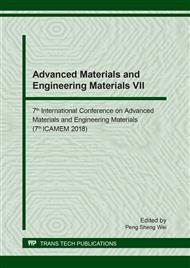[1]
S.M. Sapuan, Composite materials: Concurrent engineering approach. Butterworth-Heinemann, Oxford, (2017).
Google Scholar
[2]
M.M. Kabir, H.Wang, K.T. Lau, F.Cardona, Chemical treatments on plant-based natural fibre reinforced polymer composites: An overview, Compos. Pt. B-Eng., 43(2012) 2883-2892.
DOI: 10.1016/j.compositesb.2012.04.053
Google Scholar
[3]
B.V. Ramnath, S.J. Kokan, R.N. Raja, R.Sathyanarayanan, C.Elanchezhia, A.R. Prasad, V.M. Manickavasagam, Evaluation of mechanical properties of abaca–jute–glass fibre reinforced epoxy composite, Mater. Des., 51 (2013) 357-366.
DOI: 10.1016/j.matdes.2013.03.102
Google Scholar
[4]
L.Mohammed, M.N. Ansari, G. Pua, M. Jawaid, M.S. Islam, A review on natural fiber reinforced polymer composite and its applications, Int. J. Polym. Sci. (2015).
DOI: 10.1155/2015/243947
Google Scholar
[5]
N.Venkateshwaran, A.Elayaperumal, Banana fiber reinforced polymer composites- A review, J. Reinf. Plast. Compos., 29(2010) 2387-2396.
DOI: 10.1177/0731684409360578
Google Scholar
[6]
P.Lehtiniemi, K.Dufva, T.Berg, M.Skrifvars, P.Järvelä, Natural fiber-based reinforcements in epoxy composites processed by filament winding, J. Reinf. Plast. Compos., 30(2011) 1947-(1955).
DOI: 10.1177/0731684411431019
Google Scholar
[7]
B.Krishnakumar, T.Panneerselvam, S.Raghuraman, Effect of Chemical Treatment on Mechanical Properties of Banana and Abaca Fiber Reinforced Composites, In Applied Mechanics and Materials, 813 (2015) 25-29.
DOI: 10.4028/www.scientific.net/amm.813-814.25
Google Scholar
[8]
M.Boopalan, M.J. Umapathy, P.Jenyfer, A comparative study on the mechanical properties of jute and sisal fiber reinforced polymer composites, Silicon, 4(2012) 145-149.
DOI: 10.1007/s12633-012-9110-6
Google Scholar
[9]
S.Misri, M.R. Ishak, S.M. Sapuan, Z.Leman, The effect of winding angles on crushing behavior of filament wound hollow kenaf yarn fibre reinforced unsaturated polyester composites, Fiber. Polym., 16(2015) 2266-2275.
DOI: 10.1007/s12221-015-5447-y
Google Scholar
[10]
X.Jia, G.Chen, Y.Yu, G.Li, J.Zhu, X.Luo, C.Duan, X.Yang, D.Hui, Effect of geometric factor, winding angle and pre-crack angle on quasi-static crushing behavior of filament wound CFRP cylinder, Compos. Pt. B-Eng., 45(2013) 1336-1343.
DOI: 10.1016/j.compositesb.2012.09.060
Google Scholar
[11]
D.Ray, B.K. Sarkar, A.K. Rana, N.R. Bose, Effect of alkali treated jute fibres on composite properties, Bull. Mat. Sci., 24(2001) 129-135.
DOI: 10.1007/bf02710089
Google Scholar
[12]
S.W. Beckwith, Filament winding–the string and the glue, Compos Fab, 14, (1998) 8-12.
Google Scholar
[13]
P.K. Mallick, Fiber-Reinforced Composites: Materials, Manufacturing, and Design, third ed., CRC press, Boca Raton, (2007).
Google Scholar
[14]
S.Y. Nayak, N.M. Amin, S.S. Heckadka, V.Shenoy, C.S. Prakash, R.Mabbu. Design, Fabrication and Testing of Carbon Fiber Reinforced Epoxy Drive Shaft for All Terrain Vehicle using Filament Winding, In MATEC Web of Conferences, 153(2018) 04010.
DOI: 10.1051/matecconf/201815304010
Google Scholar
[15]
ASTM D5449 / D5449M-16, Standard Test Method for Transverse Compressive Properties of Hoop Wound Polymer Matrix Composite Cylinders, ASTM International, West Conshohocken, PA, (2016).
DOI: 10.1520/d5449_d5449m-93r00
Google Scholar
[16]
ASTM D7264 / D7264M-15, Standard Test Method for Flexural Properties of Polymer Matrix Composite Materials, ASTM International, West Conshohocken, PA, (2015).
Google Scholar


